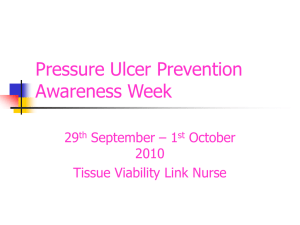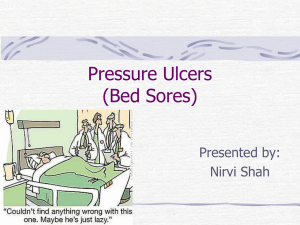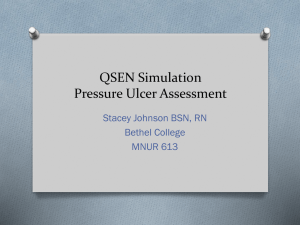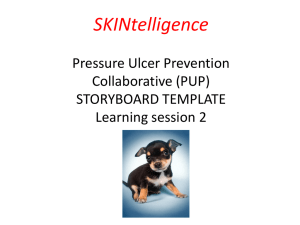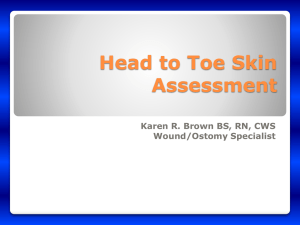Steven Tam
advertisement
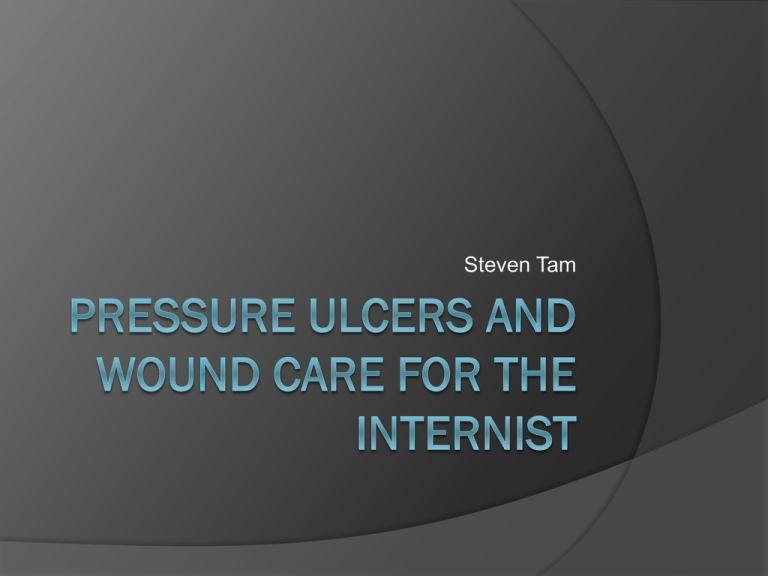
Steven Tam Objectives Understand the definitions and staging system for Pressure Ulcers Review the epidemiology Review risk factors for pressure ulcer development Review and understand prevention and treatment of pressure ulcers Case The Case of “Just a Hygiene Problem” Patient: 78 year old woman lives with her son (primary caregiver) history of diabetes difficulty walking (spinal stenosis?), wheelchair bound chronic edema brought in to the ER for altered mental status found to have a UTI 4 The Case of “Just a Hygiene Problem” Skin not checked until the patient transferred to the ward floor The RN notifies the Attending regarding the skin The Attending says “it’s normal and just a hygiene problem” to nurse, in front of all other staff Nurse calls APS 5 Is this normal? 6 PRESSURE ULCER: DEFINITION Skin lesion caused by unrelieved pressure resulting in damage to soft tissue compressed between a bony prominence and external surface over a prolonged period of time The time for pressure ulcer development is variable due to severity of illness and number of comorbid conditions Normal wound healing: Homeostasis, inflammatory, proliferative and maturation Aging can affect the wound healing process/phases Pressure Ulcers 8 Pressure Sores September 2013 National Institute on the Prosecution of Elder Abuse 9 STAGING OF PRESSURE ULCERS (1 of 5) Stage Suspected deep tissue injury Definition • • Purple or maroon localized area of discolored intact skin or blood-filled blister due to damage of underlying soft tissue from pressure and/or shear The area may be preceded by tissue that is painful, firm, mushy, boggy, warmer, or cooler than adjacent tissue Comments • Deep tissue injury can be difficult to detect in individuals with dark skin tones • Evolution can include a thin blister over a dark wound bed • The wound can further evolve and become covered by thin eschar • Evolution can be rapid and expose additional layers of tissue, even with optimal treatment Staging according to the National Pressure Ulcer Advisory Panel STAGING OF PRESSURE ULCERS (2 of 5) Stage Definition Comments Stage I • Intact skin with nonblanchable • The area may be painful, firm, redness of a localized area soft, and warmer or cooler than usually over a bony adjacent tissue prominence • Stage I can be difficult to detect • Darkly pigmented skin may not in individuals with dark skin have visible blanching; its color tones may differ from the surrounding area Stage II • Partial-thickness loss of dermis • Presents as a shiny or dry presenting as a shallow open shallow ulcer without slough or ulcer with a red-pink wound bruising (the latter indicates bed, without slough suspected deep tissue injury) • Can also present as an intact • This stage should not be used to or open/ruptured serum-filled describe skin tears, tape burns, blister perineal dermatitis, maceration, or excoriation STAGING OF PRESSURE ULCERS (3 of 5) Stage Definition Comments Stage III • Full-thickness tissue loss • Depth varies by anatomic • Subcutaneous fat can be location The bridge of the nose, visible but bone, tendon, or ear, occiput, and malleolus do muscle are not exposed not have subcutaneous tissue, • Slough may be present but and Stage III ulcers can be does not obscure the depth shallow of tissue loss • In contrast, areas of significant • Can include undermining adiposity can develop extremely and tunneling deep Stage III pressure ulcers Bone/tendon is not visible or directly palpable STAGING OF PRESSURE ULCERS (4 of 5) Stage Definition Stage IV • Full-thickness tissue loss with exposed bone, tendon, or muscle • Slough or eschar can be present on some parts of wound bed • Often include undermining and tunneling Comments • Depth varies by anatomic location • The bridge of the nose, ear, occiput, and malleolus do not have subcutaneous tissue, and these ulcers can be shallow • Stage IV ulcers can extend into muscle and/or supporting structures (eg, fascia, tendon or joint capsule), making osteomyelitis possible • Exposed bone/tendon is visible or directly palpable STAGING OF PRESSURE ULCERS (5 of 5) Stage Unstageable Definition Comments • Full-thickness • Until enough slough and/or tissue loss in which eschar is removed to expose the the base of the base of the wound, the true ulcer is covered by depth (and therefore stage) slough (yellow, tan, cannot be determined gray, green, or • Stable (dry, adherent, intact brown) and/or without erythema or fluctuance) eschar (tan, brown, eschar on the heels serves as or black) in the “the body's natural (biological) wound bed cover” and should not be removed Epidemiology: Pressure Ulcers Affect 1 million adults annually Higher risk in older people because: • • • • • Local blood supply to skin decreases Epithelial layers flatten and thin Subcutaneous fat decreases Collagen fibers lose elasticity Tolerance to hypoxia decreases 1 of 3 sentinel events for long-term care Medicare and most states’ Medicaid programs do not pay for hospital-acquired stage III or IV pressure ulcers INCIDENCE OF PRESSURE ULCERS VARIES BY SETTING 18 16 14 12 10 8 6 4 2 0 0–17% 11% 7%–9% Hospital Home Care Nursing Home PREVALENCE OF PRESSURE ULCERS VARIES BY STAGE Stages III & IV, 20% Stage I, 47% Stage II, 33% POSSIBLE COMPLICATIONS Sepsis (aerobic or anaerobic bacteremia) Localized infection, cellulitis, osteomyelitis Pain Depression Mortality rate = 60% in older people who develop a pressure ulcer within 1 year of hospital discharge RISK FACTORS Intrinsic: physiologic factors or disease states that increase the risk for pressure ulcer development Age Nutritional status Decreased arteriolar blood pressure Extrinsic: external factors that damage skin Pressure, friction, shear Moisture, urinary, or fecal incontinence FACTORS PREDICTIVE OF PRESSURE ULCER DEVELOPMENT Age 70+ Impaired mobility Current smoking Low BMI Confusion Urinary and fecal incontinence Malnutrition Restraints Many other disorders: malignancy, diabetes, stroke, pneumonia, CHF, fever, sepsis, hypotension, renal failure, dry skin, history of pressure ulcers, anemia, lymphopenia, hypoalbuminemia RISK ASSESSMENT INSTRUMENTS Widely used tools for identifying older patients at risk of developing ulcers: Norton scale Sensitivity = 73%–92%, specificity = 61%–94% Braden scale Sensitivity = 83%–100%, specificity = 64%–77% Both are recommended by Agency for Healthcare Research and Quality NORTON SCALE Provides method for assessing a patient’s pressure ulcer risk by evaluating: ○ Physical condition ○ Mental condition ○ Level of physical activity ○ Mobility ○ Continence or incontinence BRADEN SCALE Provides method for assessing pressure ulcer risk by evaluating: • Sensory perception: ability to respond to pressure- related discomfort • Moisture: degree of exposure to moisture • Activity: degree of physical activity • Mobility: ability to change and control body position • Nutrition: usual food intake http://www.bradenscale.com/ Prevention and Treatment PREVENTION An evidence-based approach to preventing pressure ulcers focuses on: ○ Skin care ○ Nutrition ○ Mechanical loading ○ Mobility ○ Support surfaces PREVENTION: SKIN CARE (1 of 2) Daily systematic skin inspection and cleansing Especially bony prominences Use warm water and mild cleanser Reduce factors that promote dryness Avoid low humidity and exposure to cold Moisturize dry skin Avoid massaging over bony prominences PREVENTION: SKIN CARE (2 of 2) Reduce moisture Incontinence Perspiration Drainage Minimize friction and shear Use proper repositioning, turning, transferring techniques Use lubricants, protective films, dressings, padding PREVENTION: NUTRITION Maintaining optimal nutrition continues to be part of national pressure ulcer prevention guidelines However, the relationship between protein-calorie malnutrition and its relationship with pressure ulcer development is unclear Avoid over-supplementing patients who do not have protein, vitamin, or nutritional deficiency Review goals of care prior to considering enteral or parenteral nutrition PREVENTION: MECHANICAL LOADING Reposition at least every 2 h (may use pillows, foam wedges) Use lubricants and protective dressings/pads Keep head of bed at lowest elevation possible Use lifting devices to decrease friction and shear Remind patients in chairs to shift weight every 15 min “Doughnut” seat cushions are contraindicated, as they may cause pressure ulcers Pay special attention to heels (account for 20% of all pressure ulcers) PREVENTING HEEL ULCERS (1 of 2) Assess heels of high-risk patients every day Use moisturizer on heels (no massage) twice a day Apply dressings to heels: Transparent film for patients prone to friction problems (eg, stroke patients) Single or extra-thick hydrocolloid dressing for those with pre-stage I reactive hyperemia PREVENTING HEEL ULCERS (2 of 2) Have patients wear: Socks to prevent friction (remove at bedtime) Properly fitting sneakers or shoes when in wheelchair Place pillow under legs to keep heels off bed Turn patients every 2 hours, repositioning heels STATIC SUPPORT SURFACES Support area Low moisture retention Reduced heat accumulation Shear reduction Pressure reduction Cost per day Foam Yes Standard mattress No Static flotation, air or water Yes No No No No No No No Yes No No Yes Yes Low Low Low DYNAMIC SUPPORT SURFACES Support area Low moisture retention Reduced heat accumulation Shear reduction Pressure reduction Cost per day AirLow air fluidized loss Alternating air Yes Yes Yes Yes Yes No Yes Yes No Yes Yes ? Yes Yes Yes High High Moderate MANAGEMENT: GENERAL ASSESSMENT Identify and effectively manage issues that have placed patient at risk of pressure ulcers: Medical diseases Health problems (eg, urinary incontinence) Nutritional status Pain level Psychosocial health MANAGEMENT: ULCER ASSESSMENT Evaluate and document: Location • Necrosis Area • Granulation Stage • Cellulitis Depth • Nonhealing wound Drainage MANAGEMENT: MONITORING HEALING Document all observations over time Describe each ulcer to track progress of healing Do not use “reverse staging” For example, stage IV cannot become stage III Ulcers are filled with granulation tissue (endothelial cells, fibroblasts, collagen, extracellular matrix) Ulcers do not replace lost muscle, subcutaneous fat, or dermis before re-epithelializing Use validated tools (eg, PUSH, see next slide) PRESSURE ULCER SCALE FOR HEALING (PUSH) A validated method to document healing over time Observe and measure the ulcer’s: Surface area: measure with centimeter ruler Exudate: estimate portion of ulcer bed covered by drainage Appearance: estimate portion of ulcer for each tissue type (epithelial, granulation, slough, necrotic) Assign weighted score to obtain total score; total scores over time indicate healing or deterioration MANAGEMENT: CONTROL OF INFECTIONS (1 of 2) Wound cleansing and dressing are the keys Increase frequency when purulent or foul-smelling drainage is first observed Avoid topical antiseptics because of their tissue toxicity With failure to heal or persistent exudate after 2 weeks of optimal cleansing, consider trial of topical antibiotics Avoid routine swab cultures MANAGEMENT: CONTROL OF INFECTIONS (2 of 2) If still no healing, consider possible cellulitis or osteomyelitis Biopsy for culture of underlying tissue, bone May need systemic antibiotics MANAGEMENT: METHODS OF DEBRIDEMENT Type Methods Comments Mechanical Wet-to-dry irrigation, hydrotherapy May remove both dead and live tissue; may be painful Surgical, sharp Scalpel, scissor to Quick, effective; use for remove dead tissue; laser infection; pain management debridement needed Enzymatic Topical agent to dissolve dead tissue Use if no infection; may damage skin Autolytic Allows dead tissue to self-digest Use if other methods not tolerated and no infection; effect delayed Biosurgery Larvae to digest dead tissue Quick, effective, good option when surgical debridement not an option MANAGEMENT: DRESSINGS (1 of 3) Transparent film: stage I, protects from friction Contraindicated: draining, suspected infection or fungus Foam island: stages II, III Contraindicated: excessive exudate; dry, crusted wound Hydrocolloid: stages II, III Contraindicated: poor skin integrity, infection, wound needs packing Petroleum-based nonadherent: stages II, III, graft sites MANAGEMENT: DRESSINGS (2 of 3) Alginate: stages III and IV, excessive drainage Contraindicated: dry or superficial wound with maceration Hydrogel, amorphous: stages II, III, IV; must combine with gauze dressing Contraindicated: maceration, excess exudate Hydrogel, sheet: stage II, skin tears Contraindicated: maceration, moderate to heavy exudate MANAGEMENT: DRESSINGS (3 of 3) Gauze packing: stages III, IV Contraindicated: deep wounds, especially those with tunneling, undermining Consider silicone-based dressings to decrease pain Silver dressings: malodorous wounds, exudative wounds, and those highly suspicious for critical bacterial load Contraindicated: systemic infection, cellulitis, fungus, interstitial nephritis, skin necrosis, concurrent use with proteolytic enzymes MANAGEMENT: NUTRITION Ensure adequate diet; prevent malnutrition Weak evidence for nutritional support that achieves 30 to 35 calories/kg/day and 1.25 to 1.5 g of protein/kg/day Weak evidence for supplemental vitamins and minerals MANAGEMENT: SURGICAL REPAIR May be used for stage III and IV ulcers Direct closure, skin grafting, skin flaps, musculocutaneous flaps, free flaps Risks and benefits of surgery must be carefully weighed for each patient: Many stage III and IV ulcers heal over a long time with local wound care Rate of recurrence of surgically closed pressure ulcers is high MANAGEMENT: ADJUNCTIVE THERAPIES No data to support low-energy laser irradiation, therapeutic ultrasound, hyperbaric oxygen Promising research continues: Recombinant platelet-derived growth factors Electrical stimulation Vegetative pressure wound therapy SUMMARY Older adults are at high risk of developing pressure ulcers Pressure ulcers may result in serious morbidity and mortality Techniques that reduce pressure, moisture, friction, and shear can prevent pressure ulcers Pressure ulcers should be treated with proper cleansing, dressings, debridement, or surgery as indicated CASE 1 (1 of 3) A 92-year-old woman is examined because a nurse has identified a suspicious area of skin on the right buttock. The patient underwent open-reduction internal fixation repair of a fractured right hip a few days earlier and was transferred to the Acute Care for the Elderly (ACE) unit from the surgery service. On examination, there is a 4 cm × 4 cm area on the right lateral buttock. It has a blood-filled blister that remains intact with surrounding dark tissue. CASE 1 (2 of 3) Which of the following is the most effective management for this finding? A. Hyperbaric therapy B. Electromagnetic therapy C. Surgical debridement D. Turning patient every 2 hours CASE 1 (3 of 3) Which of the following is the most effective management for this finding? A. Hyperbaric therapy B. Electromagnetic therapy C. Surgical debridement D. Turning patient every 2 hours CASE 2 (1 of 4) A 72-year-old man who has metastatic colon cancer is admitted to a hospice inpatient facility because of complete bowel obstruction and failure to thrive. He has been unable to tolerate oral food or fluids for several days because of nausea and vomiting, and he has significant pain throughout the day. The hospice admitting nurse documents a large sacral pressure ulcer measuring 11 cm × 10 cm, with a depth of 4 cm. There is surrounding erythema, exposed muscle, undermining of the edges, and a tunneling tract that extends another 2 cm. CASE 2 (2 of 4) Within the ulcer, there is necrotic material and a significant amount of exudate with a foul odor that permeates the room. The treatment plan includes placement of a specialized bed overlay, application of absorptive dressings, and medicine for pain control. Family members tell staff that the wound odor makes spending time in the patient’s room very difficult, and they ask if something can be done. CASE 2 (3 of 4) Which of the following is the best next step to reduce odor from the pressure ulcer? A. Turn patient every 2 hours. B. Apply topical metronidazole gel. C. Place potpourri in the room. D. Perform surgical debridement. CASE 2 (4 of 4) Which of the following is the best next step to reduce odor from the pressure ulcer? A. Turn patient every 2 hours. B. Apply topical metronidazole gel. C. Place potpourri in the room. D. Perform surgical debridement. CASE 3 (1 of 3) A 68-year-old woman is transferred to a medical ward after being treated in the intensive care unit for respiratory failure due to COPD. During an examination, the nurse notices an area of skin breakdown on the patient’s coccyx. It is 3 cm × 4 cm with a depth of 1 cm and has minimal slough. The wound edges are hyperemic, but there is no sign of undermining. Wound exudate is minimal, and there are no systemic signs of infection. CASE 3 (2 of 3) Which of the following is the most appropriate treatment for this wound? A. Alginate dressing B. Hydrocolloid dressing C. Transparent film D. Wet-to-dry dressing CASE 3 (3 of 3) Which of the following is the most appropriate treatment for this wound? A. Alginate dressing B. Hydrocolloid dressing C. Transparent film D. Wet-to-dry dressing GRS8 Slides Editor: Annette Medina-Walpole, MD, AGSF GRS8 Chapter Author: Courtney H. Lyder, ND GRS8 Question Writer: R. Morgan Bain, MD Medical Writers: Beverly A. Caley Faith Reidenbach Managing Editor: Andrea N. Sherman, MS Copyright © 2013 American Geriatrics Society
